社交媒体对品牌营销作用 英文
社交媒体在生活中的作用英语作文

社交媒体在生活中的作用英语作文英文回答:Social media has become an indispensable part of our lives, impacting various aspects of our social, personal, and professional spheres. Here are some of the key roles it plays:1. Connectivity and Communication:Social media platforms have revolutionized the way we connect and communicate with others. We can easily stay in touch with friends and family, regardless of geographic boundaries. Features like instant messaging, video calls, and social media groups foster real-time interactions and make us feel connected even when we are physically apart.2. Information Sharing and News Consumption:Social media has emerged as a primary source ofinformation for many people. It provides access to a vast amount of news, updates, and perspectives from different sources. The ability to share articles, videos, and updates allows for a broader dissemination of information and promotes discussion and dialogue.3. Personal Branding and Self-Expression:Social media platforms offer individuals a unique opportunity to showcase their personalities, interests, and talents. Through personal profiles, users can curate their online presence and establish a personal brand. They can share their thoughts, experiences, and creative content, allowing others to gain insights into their lives and perspectives.4. Professional Networking and Career Development:LinkedIn, in particular, has become an essential tool for professional networking and career development. It enables individuals to connect with potential employers, recruiters, and industry professionals. By building aprofessional profile, sharing relevant content, and engaging in group discussions, users can enhance their professional visibility and career opportunities.5. Entertainment and Leisure:Social media platforms are a major source of entertainment and leisure. Users can follow their favorite celebrities, influencers, and creators, access a wide range of videos, games, and music, and engage in interactive experiences. Social media has significantly contributed to the rise of digital entertainment and provides endless options for relaxation and enjoyment.6. Social Activism and Social Change:Social media has played a crucial role in facilitating social activism and promoting social change. Platforms like Twitter and Facebook have been used to organize protests, raise awareness about important issues, and mobilize individuals to take action. Social media provides a powerful tool for collective action and social movements,enabling individuals to connect and advocate for causes they care about.中文回答:社交媒体在生活中的作用。
3篇关于《社交媒体用于营销的利与弊》的英语六级作文

(一)作文1:The Benefits and Drawbacks of Social Media MarketingSocial media platforms have revolutionized the way businesses market their products and interact with their customers. While social media marketing offers several advantages, it also poses certain challenges. This essay will explore the benefits and drawbacks of utilizing social media for marketing purposes.On the positive side, social media provides businesses with an extensive reach and the ability to target specific demographics. Platforms like Facebook, Instagram, and Twitter have millions of active users, allowing businesses to showcase their products and services to a vast audience. Additionally, social media enables direct communication with customers, fostering engagement and building brand loyalty.Moreover, social media marketing is cost-effective compared to traditional advertising methods. Many platforms offer advertising options that can be tailored to fit any budget. This affordability makes it attractive to small businesses and startups with limited marketing resources.However, social media marketing also has its drawbacks. Firstly, managing social media accounts requires consistent effort and time commitment. Regularly creating engaging content, responding to comments, and monitoring trends can be demanding, especially for businesses with limited personnel or expertise in social media management.Furthermore, negative feedback or criticism on social media can quickly escalate and damage a business's reputation. Social media provides a public platform for customers to voice their opinions, and addressing negative comments or reviews effectively can be challenging.In conclusion, while social media marketing offers the benefits of wide reach, targeted advertising, and cost-effectiveness, businesses must also be prepared to invest time and resources in managing their social media presence. Additionally, vigilance is necessary to handle potential reputation risks associated with negative feedback. By carefully navigating the opportunities and challenges, businesses can harness the power of social media for effective marketing strategies.(二)作文2:Harnessing the Power and Limitations of Social Media MarketingIn today's digital landscape, social media has emerged as a powerful tool for businesses to promote their products and services. However, it is essential to consider both the advantages and limitations of social media marketing.One significant benefit of social media marketing is the ability to target specific audiences. Platforms like Facebook and Instagram provide advanced targeting options, allowing businesses totailor their content to reach desired demographics. By reaching the right audience, businesses can generate leads and increase conversions.Additionally, social media offers immediate and direct customer interaction. Businesses can engage with customers through comments, messages, and live chats, building relationships and enhancing customer satisfaction. Real-time feedback enables businesses to understand customer preferences and make necessary adjustments to their marketing strategies.However, social media marketing is not without drawbacks. Firstly, the overwhelming amount of content on social media platforms makes it challenging to stand out. Businesses must constantly innovate and create compelling content to capture users' attention amidst fierce competition. The ever-changing algorithms of social media platforms further complicate visibility and content delivery.Another limitation is the potential for negative publicity. One negative review or viral incident can quickly damage a company's reputation on social media. Mismanaged crises can exacerbate the situation, impacting brand image and customer trust.In conclusion, social media marketing offers businesses opportunities to target specific audiences and engage with customers directly. However, businesses must understand the challenges of content differentiation and reputation management to leverage social media effectively. By striking a balance between promotional content and genuine customer engagement, businesses can harness the potential of social media for marketing success.(三)作文3:Maximizing the Pros and Mitigating the Cons of Social Media MarketingIn the digital era, social media has emerged as a dominant platform for marketing and brand promotion. While social media marketing offers numerous advantages, it is crucial to address its drawbacks to ensure a comprehensive marketing strategy.One of the significant benefits of social media marketing is its cost-effectiveness. Compared to traditional advertising channels, platforms like Twitter and LinkedIn provide various affordable advertising options. Businesses can target specific audiences, maximize their return on investment, and reach a global customer base with a minimal budget.Furthermore, social media allows businesses to build strong connections with customers through personalized engagement. By responding to comments, messages, and reviews promptly, businesses demonstrate their commitment to customer satisfaction, fostering loyalty and generating positive word-of-mouth.However, social media marketing also presents challenges. The fast-paced nature of social media demands a constant flow of engaging content, which can strain resources and creativity. Consistencyand quality are crucial for maintaining audience interest and staying ahead of competitors.Moreover, the open nature of social media can expose businesses to public scrutiny and negative feedback. Reputation management becomes vital, necessitating a prompt and professional response to customer concerns. Implementing proactive strategies, such as monitoring social media conversations and addressing issues promptly, can help mitigate potential reputation risks.In conclusion, social media marketing offers cost-effective advertising channels and enables personalized customer engagement. However, businesses must be prepared to overcome the challenges of content creation, competition, and reputation management. By leveraging the advantages and addressing the limitations, businesses can effectively utilize social media to elevate their marketing efforts.。
社交媒体的重要性英语作文
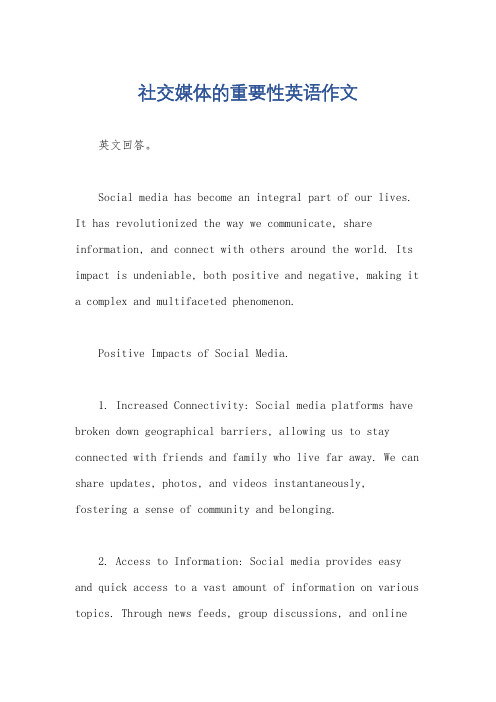
社交媒体的重要性英语作文英文回答。
Social media has become an integral part of our lives. It has revolutionized the way we communicate, share information, and connect with others around the world. Its impact is undeniable, both positive and negative, making it a complex and multifaceted phenomenon.Positive Impacts of Social Media.1. Increased Connectivity: Social media platforms have broken down geographical barriers, allowing us to stay connected with friends and family who live far away. We can share updates, photos, and videos instantaneously,fostering a sense of community and belonging.2. Access to Information: Social media provides easy and quick access to a vast amount of information on various topics. Through news feeds, group discussions, and onlineresources, we can stay informed about current events, learn new skills, and broaden our knowledge.3. Platform for Activism and Social Change: Social media has become a powerful tool for social activism and raising awareness about important issues. It allows individuals and organizations to connect, organize, and mobilize people around shared causes, leading to positive social change.4. Marketing and Business Opportunities: Social media platforms offer businesses a unique opportunity to reach and engage with potential customers. They can create targeted ads, build relationships with followers, and expand their brand's reach.5. Entertainment and Leisure: Social media provides a constant source of entertainment and leisure activities. We can share and view funny videos, play games, connect with like-minded individuals, and escape into virtual worlds.Negative Impacts of Social Media.1. Privacy Concerns: Social media companies collect vast amounts of data about their users, including personal information, browsing habits, and location. This data can be used for advertising purposes or potentially sold to third parties, raising concerns about privacy and data security.2. Cyberbullying and Harassment: Social media platforms can provide a breeding ground for cyberbullying, online harassment, and hate speech. Individuals can be targeted and subjected to hurtful and malicious behavior, impacting their mental health and well-being.3. Addiction and Mental Health Issues: Excessive use of social media can lead to addiction and have negativeeffects on mental health. It can contribute to feelings of isolation, low self-esteem, and sleep disturbances.4. Spread of Misinformation: Social media allows for the rapid spread of misinformation and fake news. False information can quickly go viral, influencing publicopinion and potentially harming individuals or society as a whole.5. Polarization and Filter Bubbles: Social media algorithms often create "filter bubbles" where users are exposed to content that aligns with their existing beliefs. This can lead to polarization and a lack of critical thinking, as individuals are less likely to encounter viewpoints that challenge their own.Conclusion.Social media is a double-edged sword. While it offers immense opportunities for connection, information sharing, and activism, it also poses challenges related to privacy, cyberbullying, addiction, and the spread of misinformation. As we navigate the evolving landscape of social media, itis crucial to use it wisely, recognizing both its potential benefits and its risks.中文回答。
pr功能介绍及使用方法
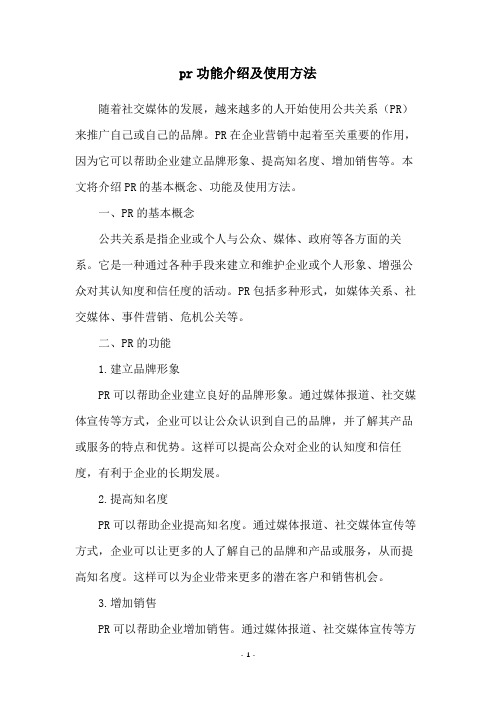
pr功能介绍及使用方法随着社交媒体的发展,越来越多的人开始使用公共关系(PR)来推广自己或自己的品牌。
PR在企业营销中起着至关重要的作用,因为它可以帮助企业建立品牌形象、提高知名度、增加销售等。
本文将介绍PR的基本概念、功能及使用方法。
一、PR的基本概念公共关系是指企业或个人与公众、媒体、政府等各方面的关系。
它是一种通过各种手段来建立和维护企业或个人形象、增强公众对其认知度和信任度的活动。
PR包括多种形式,如媒体关系、社交媒体、事件营销、危机公关等。
二、PR的功能1.建立品牌形象PR可以帮助企业建立良好的品牌形象。
通过媒体报道、社交媒体宣传等方式,企业可以让公众认识到自己的品牌,并了解其产品或服务的特点和优势。
这样可以提高公众对企业的认知度和信任度,有利于企业的长期发展。
2.提高知名度PR可以帮助企业提高知名度。
通过媒体报道、社交媒体宣传等方式,企业可以让更多的人了解自己的品牌和产品或服务,从而提高知名度。
这样可以为企业带来更多的潜在客户和销售机会。
3.增加销售PR可以帮助企业增加销售。
通过媒体报道、社交媒体宣传等方式,企业可以让更多的人了解自己的产品或服务,从而提高销售。
这样可以为企业带来更多的收益和利润。
4.维护公共形象PR可以帮助企业维护公共形象。
当企业遭遇负面事件或危机时,PR可以帮助企业通过危机公关等方式来处理事件,减少损失,保护企业形象。
三、PR的使用方法1.媒体关系媒体关系是PR的核心。
通过与媒体建立良好的关系,企业可以在媒体上获得更多的曝光机会,提高知名度和品牌形象。
建立媒体关系的方法包括:(1)发送新闻稿和新闻提示(2)邀请媒体参加企业活动(3)提供专业知识和行业见解2.社交媒体社交媒体是PR的重要手段。
通过社交媒体,企业可以与粉丝互动、分享信息、传递品牌形象。
使用社交媒体的方法包括:(1)建立社交媒体账号(2)定期发布内容(3)回应粉丝的评论和留言3.事件营销事件营销是一种通过活动来宣传品牌的方式。
广告学社交媒体中英文对照外文翻译文献

中英文对照外文翻译(文档含英文原文和中文翻译)译文:并非所有的社交媒体都是一样的:分析机构的社交媒体使用模式摘要:本研究探讨了组织如何使用消费者关系管理的各种社会媒体应用。
基于聚类分析,317组织的社会化媒体的使用模式进行了分析。
六组的组织是按照主要用于各组织的社交媒体应用程序鉴定网络版。
在第一个三组主要采用了单一的社会媒体应用(博客,社交网站,或者部件)与客户沟通,而第二三组采用多种社会化媒体应用中,常与可视化,虚拟化,或交互式协作的重点。
此外,该研究发现,企业倾向于使用具有双向通信能力社交媒体应用。
这些发现的理论和实际意义将在本文讨论。
1.引言随着业务的新媒体技术的日益显着性,企业现在正在使用新媒体工具战略性地以满足其不同客户的需求。
越来越多的新媒体技术提供能力,使企业能够为他们的客户提供了许多新的服务。
认识到使用新媒体技术的优势,大多数企业已经开始在诸如内部结构,管理系统,以及广告和公共关系(帕夫利克,2007)地区实施新的媒体技术。
特别是,组织已经以惊人的速度(巴恩斯,2008年)通过社交媒体,因为社交媒体使客户能够轻松地与组织沟通回来,来回跟上最新在它的新闻,使投诉和查询,访问聊天功能。
针对这一行业发展趋势的研究人员进行了有关社交媒体应用的研究。
首先,研究一个流(例如,格鲁尼格,2009年,卡普兰和Haenlein,2010; Lietsala和Sirkkunen,2008年,菲利普斯,2009年)已要求基于其独特的特点脱科幻NE 的应用是什么样的社会媒体和分类类型的社交媒体应用。
另一个研究流(例如,布里奥内斯等,2011; Rybalko和塞尔策,2010;沃特斯等人,2009年)取得了相当大的努力,以确定哪些类型的社交媒体应用组织正在使用以及如何特定网络C型社会媒体有助于创造和维护组织与顾客之间的关系。
但是,因为它不能提供企业的整体社交媒体使用率巳燕鸥的图片该项研究的限制范围内,特别是企业如何采用以组合的方式不同的社交媒体应用程序,以最大限度的协同效应。
英语作文-社交媒体营销策略如何促进品牌传播与销售增长

英语作文-社交媒体营销策略如何促进品牌传播与销售增长Social media marketing has become an essential part of brand promotion and sales growth in today's digital age. With the increasing popularity and influence of social media platforms, it is crucial for businesses to develop effective strategies to leverage these channels for brand communication and sales expansion.First and foremost, social media marketing allows brands to reach a wider audience and engage with their target customers on a more personal level. Through platforms such as Facebook, Instagram, Twitter, and LinkedIn, companies can create and share compelling content that resonates with their followers, building brand awareness and loyalty. By consistently interacting with their audience through comments, messages, and live sessions, brands can establish a strong online presence and cultivate a community of loyal customers who are more likely to advocate for the brand and make repeat purchases.Additionally, social media marketing enables brands to gather valuable insights about their customers' preferences, behaviors, and feedback. Through analytics tools and social listening, businesses can monitor conversations about their brand, industry, and competitors, gaining valuable market intelligence that can inform their marketing strategies and product development. By understanding the needs and desires of their target audience, brands can tailor their content and offerings to better meet customer demands, ultimately driving sales growth and customer satisfaction.Moreover, social media marketing provides opportunities for brands to collaborate with influencers and industry experts to expand their reach and credibility. By partnering with relevant personalities who have a large and engaged following, brands can access new audiences and benefit from the trust and authority that these influencers have established. Through sponsored content, product reviews, and co-branded campaigns, businesses can leverage the influence of these individuals to promote their products or services, leading to increased brand exposure and potential sales conversions.Furthermore, social media marketing offers a cost-effective way for brands to advertise and promote their offerings to a targeted audience. Through paid advertising options such as Facebook Ads, Instagram sponsored posts, and promoted tweets, businesses can reach specific demographics, interests, and behaviors, ensuring that their marketing messages are seen by the right people at the right time. This targeted approach not only maximizes the impact of marketing efforts but also allows for better measurement and optimization of campaigns, leading to improved return on investment and sales performance.In conclusion, social media marketing plays a critical role in driving brand communication and sales growth by enabling brands to reach a wider audience, engage with customers on a personal level, gather valuable insights, collaborate with influencers, and advertise to targeted demographics. As social media continues to evolve and shape consumer behavior, businesses must adapt their marketing strategies to effectively leverage these platforms for brand promotion and sales expansion. By embracing the power of social media marketing, brands can establish a strong online presence, build meaningful relationships with their customers, and drive sustainable growth in today's competitive marketplace.。
关于社交媒体的重要性英语作文
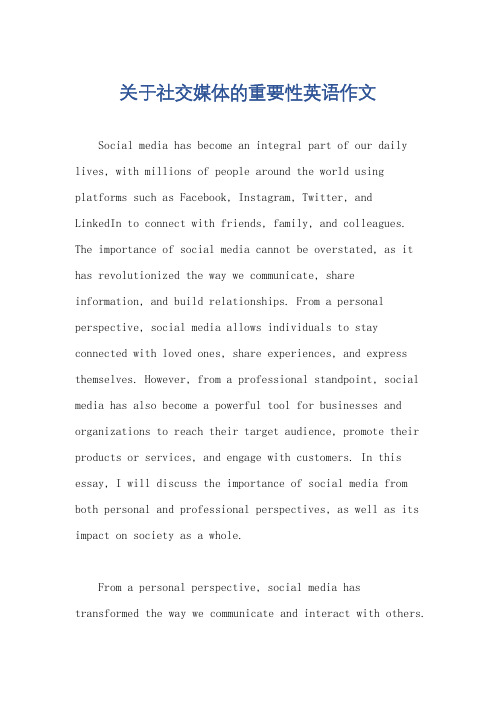
关于社交媒体的重要性英语作文Social media has become an integral part of our daily lives, with millions of people around the world using platforms such as Facebook, Instagram, Twitter, andLinkedIn to connect with friends, family, and colleagues. The importance of social media cannot be overstated, as it has revolutionized the way we communicate, share information, and build relationships. From a personal perspective, social media allows individuals to stay connected with loved ones, share experiences, and express themselves. However, from a professional standpoint, social media has also become a powerful tool for businesses and organizations to reach their target audience, promote their products or services, and engage with customers. In this essay, I will discuss the importance of social media from both personal and professional perspectives, as well as its impact on society as a whole.From a personal perspective, social media has transformed the way we communicate and interact with others.Platforms such as Facebook and Instagram allow us to stay connected with friends and family, regardless of geographical boundaries. We can share photos, videos, and updates about our lives, and stay informed about the lives of those we care about. Social media also provides a platform for self-expression, allowing individuals to share their thoughts, opinions, and creative work with a wide audience. This has led to the rise of social media influencers and content creators, who have built large followings and have the ability to influence the opinions and behaviors of their followers.Moreover, social media has also become a source of entertainment and information for many people. From viral videos to news updates, social media platforms provide a constant stream of content that keeps users engaged and informed about the world around them. This has led to the blurring of lines between traditional media and social media, with many people turning to platforms like Twitter and YouTube for news and entertainment, rather than traditional sources such as newspapers and television.From a professional perspective, social media has become an essential tool for businesses and organizations to connect with their target audience, promote their brand, and drive sales. Platforms like LinkedIn haverevolutionized the way professionals network and find job opportunities, while platforms like Facebook and Instagram have become powerful marketing tools for businesses of all sizes. Social media allows businesses to reach a global audience, engage with customers in real-time, and build brand loyalty through personalized interactions. This has led to the rise of social media marketing as a key component of many businesses' overall marketing strategy.Furthermore, social media has also had a profound impact on society as a whole, influencing the way we consume information, form opinions, and engage with current events. The rise of social media has given a voice to marginalized communities and has become a platform for social and political activism. Movements such as#BlackLivesMatter and #MeToo have gained momentum through social media, sparking important conversations and driving real-world change. On the other hand, social media has alsobeen criticized for contributing to the spread of misinformation and fake news, as well as for its potential negative impact on mental health and well-being.In conclusion, the importance of social media cannot be overstated, as it has fundamentally changed the way we communicate, share information, and build relationships. From a personal perspective, social media allowsindividuals to stay connected with loved ones, share experiences, and express themselves. From a professional standpoint, social media has become a powerful tool for businesses and organizations to reach their target audience, promote their products or services, and engage with customers. However, it is important to recognize the potential negative impact of social media and to use it responsibly, both as individuals and as a society. Associal media continues to evolve, it will be crucial to consider its impact on our lives and to use it in a waythat promotes positive change and meaningful connections.。
互联网营销中的KOL和MCN的作用

互联网营销中的KOL和MCN的作用现今社交媒体的盛行,让广告营销方式也出现了全新的转变。
对于品牌主而言,通过选择合适的社交媒体KOL和MCN合作,既可以有效地扩大自己的品牌知名度,还能够让消费者轻松了解产品和服务,提升消费从意识到决策的转化。
KOL和MCN的作用KOL(Key Opinion Leader)指的是社交媒体上影响力较大的关键意见领袖,如微博上的大V、知乎上的行业达人、抖音上的选手等。
他们所拥有的粉丝和粉丝的互动量,能够让品牌主更好的获得市场口碑和良好的认知度。
MCN(Multi-channel Network)指的是多渠道网络,主要由多名KOL组成,旨在提供更优质的内容制作服务,以此与品牌合作来获得更大范围的曝光率和转化率。
MCN以聚合KOL的能力,扩大了品牌的传播范围与效果,是营销资源集成的优质平台。
广告主和营销策划人员可以寻找到影响力较大的KOL和MCN 合作,让他们去为自己的品牌或产品进行内容制作和推广,以此促进销售。
一方面,KOL因为拥有大量的粉丝,能够在有影响力的人群中传播广告内容,另一方面,MCN能够帮助广告主完成更高质量的内容制作,保证广告内容符合目标顾客的需求和口味。
KOL和MCN品牌营销案例KOL和MCN的品牌营销是一个互相促进和互相影响的关系,他们能够帮助品牌进行更广泛的宣传和推广,让消费者了解品牌和产品更多的细节。
下面列举几个品牌营销案例,总结KOL和MCN在品牌营销中的优势和贡献。
斗鱼直播KOL带货作为中国最大的游戏直播平台,斗鱼直播通过与KOL主播合作,为游戏品牌提供了新的营销平台。
通过和主播合作,品牌可以将游戏、电竞产品以及周边产品更好地推广,进而推动销售,并且让广告观众更接近产品,更方便更快速的选择购买。
虎牙嘉年华MCN营销虎牙嘉年华是由虎牙直播MCN和品牌主合作的大型活动,以互动性强、饮食文化为主题,邀请MCN和KOL打造个性化的推广内容。
虎牙嘉年华旨在通过品牌主的选择,选择在虎牙平台上流行的城市活动、节庆活动和影视文化活动,进而快速提升品牌知名度,增强品牌的认知度并吸引更多的忠实客户。
品牌营销英文作文

品牌营销英文作文Brand marketing is all about creating a strong and memorable image for your company. It's about making people feel a certain way when they see or hear your brand name.It's about connecting with your audience on an emotional level and building a relationship with them.One of the most important aspects of brand marketing is consistency. You need to make sure that your brand message is consistent across all of your marketing channels, from your website to your social media to your advertising. This helps to reinforce your brand image and make it more memorable to your audience.Another key element of brand marketing is storytelling. People love a good story, and if you can tell a compelling story about your brand, it can help to create a strong emotional connection with your audience. Whether it's the story of how your company was founded or the story of a customer who had a great experience with your product,storytelling can be a powerful tool in brand marketing.In addition to consistency and storytelling, another important aspect of brand marketing is understanding your target audience. You need to know who your ideal customer is, what they care about, and how they like to be communicated with. This will help you tailor your brand message and marketing efforts to better resonate with your audience.Finally, brand marketing is about creating a unique and memorable brand identity. This includes everything from your logo and color scheme to your brand voice and personality. The more unique and memorable your brand identity is, the more likely it is that people will remember and recognize your brand.In conclusion, brand marketing is all about creating a strong and memorable brand image, being consistent in your messaging, telling compelling stories, understanding your audience, and creating a unique brand identity. By focusing on these key elements, you can build a successful brandthat resonates with your audience and stands out in the market.。
新媒体社交媒体营销中英文对照外文翻译文献
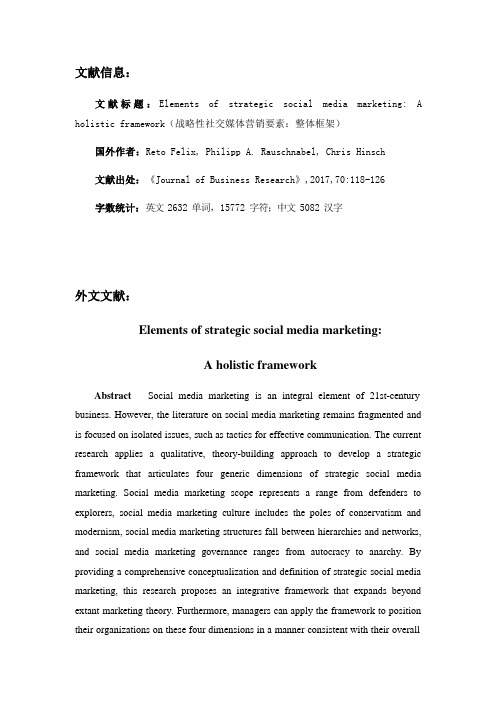
文献信息:文献标题:Elements of strategic social media marketing: A holistic framework(战略性社交媒体营销要素:整体框架)国外作者:Reto Felix, Philipp A. Rauschnabel, Chris Hinsch文献出处:《Journal of Business Research》,2017,70:118-126字数统计:英文 2632 单词,15772 字符;中文 5082 汉字外文文献:Elements of strategic social media marketing:A holistic frameworkAbstract Social media marketing is an integral element of 21st-century business. However, the literature on social media marketing remains fragmented and is focused on isolated issues, such as tactics for effective communication. The current research applies a qualitative, theory-building approach to develop a strategic framework that articulates four generic dimensions of strategic social media marketing. Social media marketing scope represents a range from defenders to explorers, social media marketing culture includes the poles of conservatism and modernism, social media marketing structures fall between hierarchies and networks, and social media marketing governance ranges from autocracy to anarchy. By providing a comprehensive conceptualization and definition of strategic social media marketing, this research proposes an integrative framework that expands beyond extant marketing theory. Furthermore, managers can apply the framework to position their organizations on these four dimensions in a manner consistent with their overallcorporate mission and objectives.Key Words: Strategic social media marketing; Holistic framework; New media; Definition of social media marketing; Social media strategy; Digital marketing1.IntroductionUnderstanding the role of social media in the context of marketing is critical for both researchers and managers (e.g. Fong & Burton, 2008; Kumar, Bezawada, Rishika, Janakiraman, & Kannan, 2016; Schultz & Peltier, 2013). Most existing studies focus on particular issues, such as purchase behavior (Chang, Yu, & Lu, 2015; Kumar et al., 2016; Relling, Schnittka, Sattler, & Johnen, 2016), customer relationship management (Trainor, Andzulis, Rapp, & Agnihotri, 2014), brand management (Asmussen, Harridge-March, Occhiocupo, & Farquhar, 2013), innovation management (Gebauer, Füller, & Pezzei, 2013), and employee recruitment (Sivertzen, Nilsen, & Olafsen, 2013). While these studies detail advancements in specialized areas of social media knowledge in a marketing and management context, extant literature does not provide a holistic framework for social media marketing at the strategic level. This deficiency is surprising because both academics (Labrecque, vor dem Esche, Mathwick, Novak, & Hofacker, 2013; Schultz & Peltier, 2013; Yadav & Pavlou, 2014) and practitioners (Divol, Edelman, & Sarrazin, 2012) acknowledge new complexities accompanying these media and agree that research into social media marketing needs to be reconceptualized. In a nutshell, strategic social media marketing remains an untested user interaction paradigm (Naylor, Lamberton, & West, 2012) with little published academic research.The current article aims to address this theoretically and managerially important research gap by exploring the following two research questions: How is strategic social media marketing defined and conceptualized? and What factors demand consideration when constructing an organization's social media marketing strategy?Specifically, this research attempts to define the continua on which critical strategic social media marketing decisions lie and to integrate them into a holistic framework.2.MethodologyThe study employed a two-stage research design. The first stage consisted of in- depth interviews (Fontana & Frey, 1998) with seven European social media marketing experts who possess both national and international experience in social media marketing. Following a purposive sampling strategy (Lincoln & Guba, 1985), experts were recruited according to their job position, experience, and direct exposure to social media marketing practices in real industry settings. Seeking depth rather than breadth, the sample size in stage 1 was commensurate with the qualitative research paradigm in which relatively small sample sizes are used to generate information-rich data (Patton, 1990). All informants agreed to audiotape the interviews (between 25 and 60 min), which resulted in 117 pages of double-spaced, verbatim transcripts.The second stage of the data collection procedure consisted of a qualitative survey of social media marketing experts (Miles & Huberman, 1994). The survey data were used not for confirmation but as a new and independent qualitative data source with a focus on triangulating the information obtained through the depth interviews and online surveys (Jack & Raturi, 2006). Respondents came from a list of 265 social media marketing experts identified through managerially focused magazines, through interviews in business magazines, or because they were mentioned as knowledgeable and experienced experts in personal communication. E-mail requests were sent to all experts along with two reminders, which resulted in 50 returned surveys (response rate = 18.9%). Seven data sets were eliminated because of incomplete answers or because social media marketing plays a minor role in the respondents' daily work. The final sample consisted of 43 respondents (age: m = 37; SD = 9 years; 74% male; 88% European) with various backgrounds in their position and/or industry.Table 1 Summary of stage 2 informantsCompany size (employees)< 50 14 (32.6%) 50–99 5 (11.6%) 100–499 3 (7.0%) 500–999 8 (18.6%) 1000–4999 6 (14.0%) 5000–10,000 3 (7.0%) >10,000 4 (9.3%)Social media marketing experience (in years)Average: 6.4 years 1–2 5 (11.6%) 3–5 19 (44.2%) 6–8 12 (27.9%) 9 and more 7 (16.3%)Percentage of working time associated with social mediaAverage: 52.8%<20% 7 (16.3%) 20–39 10 (23.3%) 40–59 6 (14.0%) 60–79 3 (7%)80–100 15 (34.9%)n/a 2 (4.7%)Age (in years)Average:37< 309 (20.9%)30–3919 (44.2%)40–4910 (23.3%)50–59 5 (11.6%)Self-reported experience in…Means aSocial Media 6.2Social Media Marketing 5.9Marketing 5.7Customer Management 4.7Advertising 5.2Communications/Public Relations 5.6a How much experience do you have in the following areas? (1 = no experience at all; 7 = highly experienced)Respondents were asked to (1) define social media marketing, (2) discuss self- selected best and worst practice examples of social media marketing, (3) discuss success factors and success metrics, and (4) describe their ideal implementation of social media marketing in a self-selected organization. The survey employed common design techniques (Smyth, Dillman, Christian, & Mcbride, 2009), such as adding large answer fields and asking respondents to be as specific as possible, to increase respondents' motivation to provide detail.3.FindingsFig. 1 shows the strategic social media marketing framework with its four central dimensions.Fig. 1. Strategic social media marketing framework.First, social media marketing scope addresses the question whether companies use social media marketing predominantly for communication with one or a few stakeholders or comprehensively (both externally and internally) as a genuine tool for collaboration. Defenders use social media marketing primarily as a one-way communication tool to entertain consumers or to inform stakeholders, rather than integrating employees or community groups. Conversely, explorers are interested in an authentic social media marketing collaboration based on reciprocal interactions with many different stakeholders such as clients, employees, suppliers, and government agents.Second, social media marketing culture distinguishes between conservatism, which is represented by an encapsulated, traditional, mass advertising approach to social media marketing, and modernism, which is characterized by a more permeable, open, and flexible social media marketing culture.Third, social media marketing structure addresses the organization and departmentalization of the social media marketing assignment in the firm. Hierarchies stand for a centralized approach with a clearly defined social media marketing assignee. Networks represent an organizational structure in which all employees are responsible for social media marketing, and thus a dedicated social media marketing director is no longer necessary.Fourth, social media marketing governance refers to how the company establishes rules and guidelines and how social media marketing responsibilities are controlled in the company. The extreme position of autocracy describes a situation with precise regulations on who in the company is allowed to interact on social media platforms. Conversely, anarchy represents a situation without any such rules or guidelines.The current research focuses on the extremes of each continuum, but, in general, firms likely choose (intentionally or unintentionally) a position somewhere between the poles on each dimension. For example, companies need to find a position on social media marketing governance that neither regulates everything employees are allowed to say nor leaves them without any guidance on which to base their responsibilities or behaviors. Fig. 1 also suggests that decisions on social media marketing should indeed be guided by the firm's internal influencers (e.g., general vision, mission, corporate goals, corporate culture, available resources), which in turn should be in line with external influencers (e.g., communities, competition, government regulation).4.Discussion and implicationsThis research addresses the absence of a holistic framework for strategic social media marketing. A review of the marketing literature reveals several approaches regarding aspects of strategic marketing such as customer relationship management (e.g., Payne & Frow, 2005) or marketing organization (Workman, Homburg, & Gruner, 1998). However, few articles address the strategic marketing of social media, and none put forth a holistic social media marketing framework.While extant research related to social media marketing investigates social media mostly through the lens of a particular marketing problem (e.g. Fong & Burton, 2008; Kim & Ko, 2012; Kumar et al., 2016) or witha focus on customers and communication (e.g., Chang et al., 2015), the findings of this study reveal four general social media marketing dimensions that firms should address when conceptualizing or managing their strategic social media marketing approach. As the findings indicate, these dimensions are interdependent, and companies should strive to position themselves on the four dimensions in an integrated way, rather than treating them as isolated, independent decisions.4.1.A new definition of social media marketingThis research suggests a new definition of social media marketing: Social media marketing is an interdisciplinary and cross-functional concept that uses social media (often in combination with other communications channels) to achieve organizational goals by creating value for stakeholders. On a strategic level, social media marketing covers an organization's decisions about social media marketing scope (ranging from defenders to explorers), culture (ranging from conservatism to modernism), structure (ranging from hierarchies to networks), and governance (ranging from autocracy to anarchy).4.2.Implications for social media marketing scopeSocial media marketing provides firms with an opportunity to use social media tobuild relationships with customers, employees, communities, and other stakeholders (i.e., when they act as explorers). At the same time, firms may choose to view social media as simply another communications channel through which they can push information to customers (i.e., when they act as defenders). Though potentially creating value for customers, the defender approach does not take advantage of the opportunities for building real relationships within the network of customers, employees, interest groups, the government, and other stakeholders, as propagated by modern relationship marketing (Payne & Frow, 2005). However, the explorer approach may require firms to redefine the role of different stakeholders in the organization.4.3.Implications for social media marketing cultureManagement and organizational behavior researchers (Zheng et al., 2010) as well as marketing academics and practitioners (Deshpandé & Farley, 2004) recognize the importance of culture and organizational climate for financial and non-financial firm performance. The current research emphasizes the importance of culture for social media marketing. Companies engaging in social media marketing must acknowledge that stakeholders can take control of and manipulate social media content (Labrecque et al., 2013). Thus, companies should contemplate the trade-offs between an encapsulated social media marketing culture (conservatism), which provides more control of important brand constructs, and consumers' desire to connect and engage with firms displaying a more progressive, permeable culture (i.e., modernism).4.4.Implications for social media marketing structureExtant marketing research investigates how the elements of marketing should be organized according to a firm's structural characteristics, such as formalization, centralization, and specialization (e.g., Olson, Slater, & Hult, 2005). Consequently, social media marketing structure focuses on responsibilities and organizational hierarchies employed to configure social media marketing. Whereas social mediamarketing governance pertains to who can or should say what in social media, social media marketing structure focuses on who has the responsibility to post and interact in these media. As the informants emphasized, firms should integrate social media marketing in a way that fits with their overarching strategies. The informants identified different sets of benefits that can emerge from either a hierarchical or a networked structure. However, they recommended that specific decisions about who has the responsibility to interact online with customers, activists, and pundits should be formally discussed in the organization.4.5.Implications for social media marketing governanceResearch on governance usually investigates the structures, rights, and responsibilities among different employees in organizations (Freeman & Reed, 1983). Information technology (IT) governance, as a sub-discipline of corporate governance, focuses on specifying which individuals have the responsibility for making decisions on the use of IT (Brown & Grant, 2005). Whereas IT governance traditionally focuses on the use of IT for work-related purposes, social media can potentially be used by any employee in either official (company-granted access) or unofficial (personal account access) capacities. Therefore, the applicability of IT governance research is of limited use when extended to social media marketing. Some companies have developed the idea of educating employees about the personal and firm-related consequences of “undesirable” social media use through social media marketing guidelines (Linke & Zerfass, 2013). However, building social media guidelines and governance into a holistic framework for social media marketing is novel. The role of employees in promoting brands in other contexts (and thus increasing firm value) is well represented in the academic literature (Morhart, Herzog, & Tomczak, 2009). Weber Shandwick's (2014) recent study reveals an emerging movement termed “employee activism” in which one-third of the surveyed respondents were social media activists who defended their employers and advocated for the firm online. Employees may be better able to understand the needs of consumers and products thatcan meet those needs, and they can effectively advocate and promote the firm online. These technologies have allowed virtually all employees to champion the firm. For example, the fashion retailer Nordstrom has policies to provide employees with knowledge, direction, and expectations. This application of social media marketing governance can increase the overall social media marketing success of the firm (Nordstrom, 2015; Ross, Beath, & Sebastian, 2015).5.Limitations and future researchSeveral limitations to the current study suggest potentially fruitful avenues for future research. First, the qualitative approach reveals four dimensions of strategic social media marketing and identifies the extreme points of each dimension. However, future research could use quantitative approaches to identify the impact of different positions on each of these dimensions. Research could also investigate the influence of each dimension on firm or social media marketing performance. For example, studies could try to isolate the effect of each dimension on outcome variables such as consumer–brand engagement (Schultz & Peltier, 2013) or, more specifically, new media brand engagement (Hennig-Thurau et al., 2010). A second limitation is the over-representation of European (especially German) informants in the analyses. Prior research discusses cross-cultural differences in consumers' use of social media (Bernoff & Li, 2008; World Newsmedia Network, 2015). Furthermore, extant research advocates for the adaptation of social media content to the targeted culture based on differing consumer profiles (Tsai & Men, 2012). Thus, caution should be taken in extrapolating the framework to other cultural contexts. Future research might determine whether aspects of cultural or economic context add dimensions to the proposed framework or whether they simply require different approaches regarding the four dimensions.Future research should also investigate how other characteristics, such as culture,the type of firm (e.g., B2B vs. B2C), the industry (e.g., financial services vs. advertising agency), company size, or available resources, influence a firm's “ideal position” on each of the dimensions of strategic social media marketing. Finally, future research could investigate the role of regulatory or self-regulatory bodies (e.g., Word of Mouth Marketing Association) on social media marketing governance and how firms can create value and form core competencies by superseding these requirements.6.ConclusionThis study sheds light on the complex nature of strategic social media marketing. Social media marketing, in practice, is too complex to be managed and executed exclusively by a single individual or even department. Cross-functional collaborations along the four dimensions of social media marketing are necessary to successfully navigate in this dynamic arena.中文译文:战略性社交媒体营销要素:整体框架摘要社交媒体营销是21 世纪商业的一个组成部分。
社交媒体营销的重要性英语作文
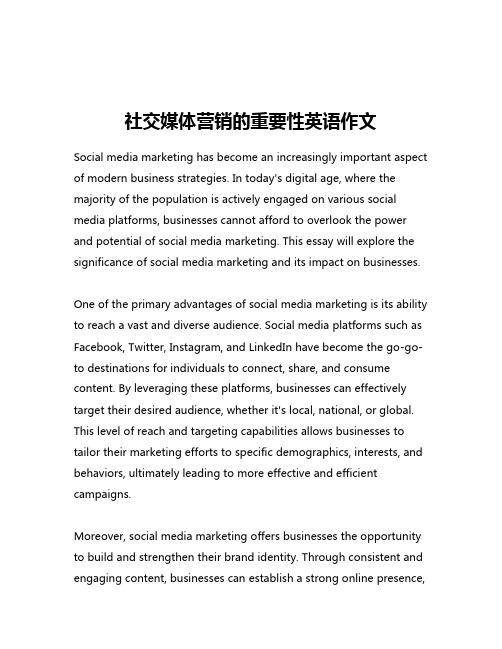
社交媒体营销的重要性英语作文Social media marketing has become an increasingly important aspect of modern business strategies. In today's digital age, where the majority of the population is actively engaged on various social media platforms, businesses cannot afford to overlook the power and potential of social media marketing. This essay will explore the significance of social media marketing and its impact on businesses.One of the primary advantages of social media marketing is its ability to reach a vast and diverse audience. Social media platforms such as Facebook, Twitter, Instagram, and LinkedIn have become the go-go-to destinations for individuals to connect, share, and consume content. By leveraging these platforms, businesses can effectively target their desired audience, whether it's local, national, or global. This level of reach and targeting capabilities allows businesses to tailor their marketing efforts to specific demographics, interests, and behaviors, ultimately leading to more effective and efficient campaigns.Moreover, social media marketing offers businesses the opportunity to build and strengthen their brand identity. Through consistent and engaging content, businesses can establish a strong online presence,cultivate brand recognition, and foster a sense of community among their followers. This brand-building process is crucial in today's competitive landscape, as consumers are increasingly drawn to businesses that align with their values and provide a meaningful connection.Another significant aspect of social media marketing is its ability to foster customer engagement and interaction. Unlike traditional marketing channels, social media platforms enable businesses to engage in real-time dialogues with their customers. This two-way communication allows businesses to receive immediate feedback, address customer concerns, and build stronger relationships with their target audience. By actively listening to and responding to customer feedback, businesses can improve their products, services, and overall customer experience, ultimately leading to increased loyalty and brand advocacy.In addition to its impact on customer engagement, social media marketing also plays a crucial role in driving website traffic and generating leads. Businesses can leverage various social media tactics, such as sharing engaging content, running targeted advertising campaigns, and collaborating with influential figures (influencers), to drive potential customers to their website or online platforms. This increased traffic can then be converted into leads, sales, and ultimately, business growth.Furthermore, social media marketing provides businesses with valuable data and insights that can inform their overall marketing strategy. Social media platforms offer a wealth of analytics and metrics, allowing businesses to track the performance of their campaigns, understand their target audience's behavior, and make data-driven decisions. This data-driven approach enables businesses to continuously optimize their marketing efforts, ensuring that their resources are being used effectively and efficiently.It is important to note that the successful implementation of social media marketing requires a well-planned and executed strategy. Businesses must understand the unique characteristics and best practices of each social media platform, as well as the preferences and behaviors of their target audience. Additionally, businesses must be willing to invest time and resources into creating high-quality, engaging content, and actively managing their online presence to maintain a positive brand image.In conclusion, the importance of social media marketing cannot be overstated. By leveraging the power of social media, businesses can reach a wider audience, build stronger brand identity, foster customer engagement, drive website traffic, and generate valuable data insights. As the digital landscape continues to evolve, businesses that embrace social media marketing and incorporate itinto their overall marketing strategy are more likely to thrive and succeed in the competitive marketplace.。
社交媒体作用的英语作文
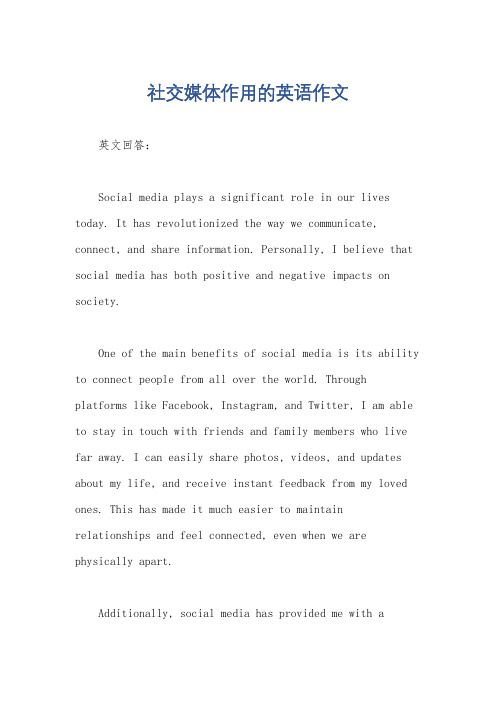
社交媒体作用的英语作文英文回答:Social media plays a significant role in our lives today. It has revolutionized the way we communicate, connect, and share information. Personally, I believe that social media has both positive and negative impacts on society.One of the main benefits of social media is its ability to connect people from all over the world. Through platforms like Facebook, Instagram, and Twitter, I am able to stay in touch with friends and family members who live far away. I can easily share photos, videos, and updates about my life, and receive instant feedback from my loved ones. This has made it much easier to maintainrelationships and feel connected, even when we are physically apart.Additionally, social media has provided me with aplatform to express myself and share my thoughts and opinions with a wider audience. I can join online communities and discussions about topics that interest me, and engage in meaningful conversations with people who have different perspectives. This has helped me broaden my horizons, learn new things, and become more open-minded.However, social media also has its downsides. One of the biggest drawbacks is the negative impact it can have on mental health. The constant comparison to others, the pressure to present a perfect image online, and the fear of missing out can all contribute to feelings of inadequacy, anxiety, and depression. I have personally experienced moments of self-doubt and insecurity while scrolling through my social media feeds, comparing my life to others' highlight reels.Furthermore, social media can be a breeding ground for misinformation and fake news. It is easy for false information to spread rapidly and be accepted as truth, leading to confusion, division, and even harm. I have seen how quickly rumors can spread on social media, causingpanic and fear among the public.In conclusion, social media has become an integral part of our lives, for better or for worse. It has the power to connect us, empower us, and educate us, but it also has the potential to harm our mental health and spread misinformation. It is important to use social media mindfully, to be aware of its impact on our well-being, and to seek a balance between online and offline interactions.中文回答:社交媒体在我们今天的生活中扮演着重要的角色。
社交媒体带来的好处交流方面英语作文
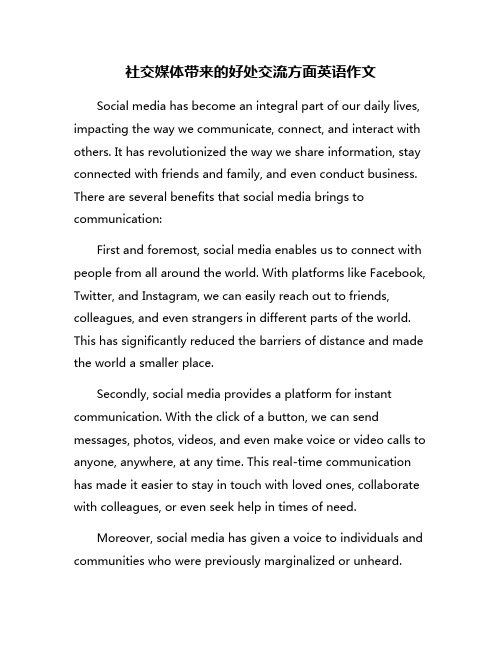
社交媒体带来的好处交流方面英语作文Social media has become an integral part of our daily lives, impacting the way we communicate, connect, and interact with others. It has revolutionized the way we share information, stay connected with friends and family, and even conduct business. There are several benefits that social media brings to communication:First and foremost, social media enables us to connect with people from all around the world. With platforms like Facebook, Twitter, and Instagram, we can easily reach out to friends, colleagues, and even strangers in different parts of the world. This has significantly reduced the barriers of distance and made the world a smaller place.Secondly, social media provides a platform for instant communication. With the click of a button, we can send messages, photos, videos, and even make voice or video calls to anyone, anywhere, at any time. This real-time communication has made it easier to stay in touch with loved ones, collaborate with colleagues, or even seek help in times of need.Moreover, social media has given a voice to individuals and communities who were previously marginalized or unheard.Platforms like Twitter have been instrumental in spreading awareness about social issues, political movements, and humanitarian crises. People can now mobilize and organize themselves to create meaningful change and make a difference in the world.In addition, social media has facilitated the sharing of ideas, knowledge, and resources. It has become a valuable tool for learning, networking, and professional development. By following experts in our fields, joining online communities, or participating in webinars and online courses, we can expand our knowledge, skills, and opportunities for growth.Furthermore, social media has transformed the way businesses communicate with their customers. Companies can now engage with their target audience, gather feedback, and provide customer support in a more efficient and personalized manner. Social media marketing has also become a powerful tool for promoting products and services, reaching new customers, and building brand loyalty.Lastly, social media has enriched our social lives by allowing us to share moments, memories, and experiences with our friends and followers. Whether it's posting updates about our lives, sharing photos and videos from special events, or creatingand participating in online challenges and trends, social media has become a platform for self-expression, creativity, and connection.In conclusion, social media has brought numerous benefits to communication, enabling us to connect with others, share information, raise awareness, learn and grow, promote businesses, and enrich our social lives. While it has its drawbacks and challenges, the positive impacts of social media on communication cannot be overstated. It has become an indispensable tool for building relationships, fostering connections, and shaping the way we interact with the world around us.。
英语作文-社交媒体营销策略如何提高用户参与度与品牌忠诚度

英语作文-社交媒体营销策略如何提高用户参与度与品牌忠诚度In the digital age, social media marketing has become a cornerstone for businesses looking to enhance user engagement and brand loyalty. The interactive nature of social media platforms allows brands to connect with their audience in real-time, fostering a sense of community and belonging among users. To leverage social media effectively, marketers must employ strategies that resonate with their target audience, encouraging active participation and nurturing a loyal customer base.Engagement-Driven Content Creation。
Creating content that prompts user interaction is vital. This includes asking questions, creating polls, and encouraging users to share their experiences. For instance, a beauty brand might ask followers to post pictures using their products, creating a ripple effect of user-generated content that boosts visibility and engagement.Leveraging User-Generated Content。
社交媒体影响者英语作文

社交媒体影响者英语作文英文回答:Social media influencers have emerged as a significant force in the digital landscape, shaping consumer behavior, promoting products, and influencing public opinion. Their impact extends across various industries, transforming the ways businesses market their offerings and individuals engage with brands.Influencers' Role in Marketing:Social media influencers possess the ability to connect with large and highly engaged audiences. They have built trust and authenticity with their followers, making them effective advocates for products and services. Businesses leverage this influence to reach a wider target market, increase brand awareness, and drive sales.Content Creation and Engagement:Influencers create engaging content that resonates with their specific niche. They share their experiences, reviews, and recommendations, providing valuable insights to their followers. This content encourages engagement, fostersbrand loyalty, and generates leads for businesses.Impact on Consumer Behavior:Social media influencers have a profound impact on consumer behavior. Their recommendations and endorsements can sway purchasing decisions, shape perceptions of products, and drive demand. Consumers trust influencers' opinions and rely on them to provide unbiased information and guidance.Challenges and Ethical Considerations:The rise of social media influencers has also brought forth challenges. Transparency and authenticity are crucial, as consumers expect honest and genuine endorsements. Paid partnerships and sponsored content must be clearlydisclosed to maintain credibility. Furthermore, influencers must adhere to ethical guidelines to avoid misleading or deceptive practices.Influence on Society:Beyond marketing, social media influencers have broader societal implications. They can contribute to social causes, raise awareness about important issues, and promotepositive values. However, they also have the potential to spread misinformation, reinforce stereotypes, andperpetuate harmful societal norms.中文回答:社交媒体影响者的英语作文:社交媒体影响者已经成为数字领域的一股重要力量,他们可以塑造消费者的行为、推广产品并影响公众舆论。
社交媒体在品牌营销中的作用
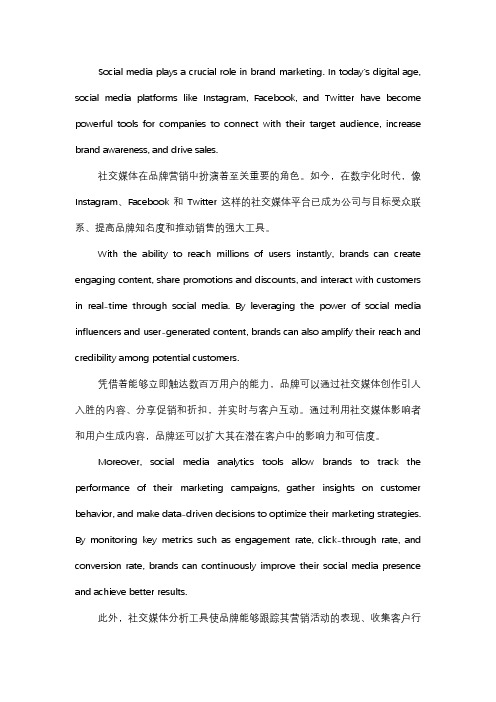
Social media plays a crucial role in brand marketing. In today's digital age, social media platforms like Instagram, Facebook, and Twitter have become powerful tools for companies to connect with their target audience, increase brand awareness, and drive sales.社交媒体在品牌营销中扮演着至关重要的角色。
如今,在数字化时代,像Instagram、Facebook和Twitter这样的社交媒体平台已成为公司与目标受众联系、提高品牌知名度和推动销售的强大工具。
With the ability to reach millions of users instantly, brands can create engaging content, share promotions and discounts, and interact with customers in real-time through social media. By leveraging the power of social media influencers and user-generated content, brands can also amplify their reach and credibility among potential customers.凭借着能够立即触达数百万用户的能力,品牌可以通过社交媒体创作引人入胜的内容、分享促销和折扣,并实时与客户互动。
通过利用社交媒体影响者和用户生成内容,品牌还可以扩大其在潜在客户中的影响力和可信度。
Moreover, social media analytics tools allow brands to track the performance of their marketing campaigns, gather insights on customer behavior, and make data-driven decisions to optimize their marketing strategies. By monitoring key metrics such as engagement rate, click-through rate, and conversion rate, brands can continuously improve their social media presence and achieve better results.此外,社交媒体分析工具使品牌能够跟踪其营销活动的表现、收集客户行为洞察,并做出基于数据的决策来优化他们的营销策略。
